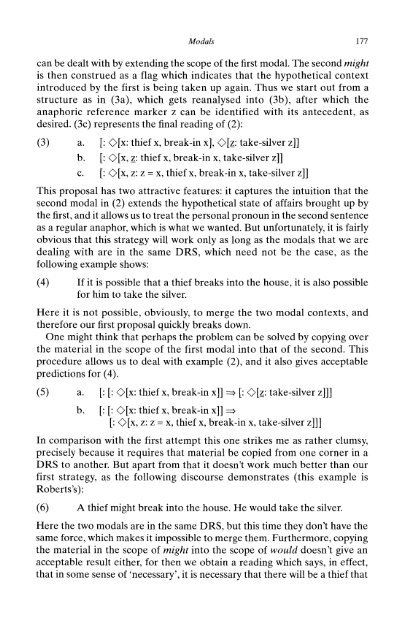Presuppositions and Pronouns - Nijmegen Centre for Semantics
Presuppositions and Pronouns - Nijmegen Centre for Semantics
Presuppositions and Pronouns - Nijmegen Centre for Semantics
You also want an ePaper? Increase the reach of your titles
YUMPU automatically turns print PDFs into web optimized ePapers that Google loves.
Modals 177 111<br />
can be dealt with by extending the scope of the first modal. The second might<br />
is then construed as a flag which indicates that the hypothetical context<br />
introduced by the first is being taken up again. Thus we start out from a<br />
structure as in (3a), which gets reanalysed into (3b), after which the<br />
anaphoric reference marker z can be identified with its antecedent, as<br />
desired. (3c) represents the final reading of (2):<br />
(3) a. [: O[x: [x: thief x, break-in x], O[z: [z: take-silver z]]<br />
b. [: [x, O[x, z: thief x, break-in x, take-silver z]]<br />
c. [: [x, O[x, z: z = x, thief x, break-in x, take-silver z]]<br />
This proposal has two attractive features: it captures the intuition that the<br />
second modal in (2) extends the hypothetical state of affairs brought up by<br />
the first, <strong>and</strong> it allows us to treat the personal pronoun in the second sentence<br />
as a regular anaphor, which is what we wanted. But un<strong>for</strong>tunately, it is fairly<br />
obvious that this strategy will work only as long as the modals that we are<br />
dealing with are in the same DRS, which need not be the case, as the<br />
following example shows:<br />
(4) If it is possible that a thief breaks into the house, it is also possible<br />
<strong>for</strong> him to take the silver.<br />
Here it is not possible, obviously, to merge the two modal contexts, <strong>and</strong><br />
there<strong>for</strong>e our first proposal quickly breaks down.<br />
One might think that perhaps the problem can be solved by copying over<br />
the material in the scope of the first modal into that of the second. This<br />
procedure allows us to deal with example (2), <strong>and</strong> it also gives acceptable<br />
predictions <strong>for</strong> (4).<br />
(5) a. [: [: [x: O[x: thief x, break-in x]] => ~ [: [z: O[z: take-silver z]]]<br />
b. [: [: [x: O[x: thief x, break-in x]] => ~<br />
[: [x, O[x, z: z = x, thief x, break-in x, take-silver z]]]<br />
In comparison with the first attempt this one strikes me as rather clumsy,<br />
precisely because it requires that material be copied from one corner in a<br />
DRS to another. But apart from that it doesn't work much better than our<br />
first strategy, as the following discourse demonstrates (this example is<br />
Roberts's):<br />
(6) A thief might break into the house. He would take the silver.<br />
Here the two modals are in the same DRS, but this time they don't have the<br />
same <strong>for</strong>ce, which makes it impossible to merge them. Furthermore, copying<br />
the material in the scope of might into the scope of would doesn't give an<br />
acceptable result either, <strong>for</strong> then we obtain a reading which says, in effect,<br />
that in some sense of 'necessary', it is necessary that there will be a thief that














